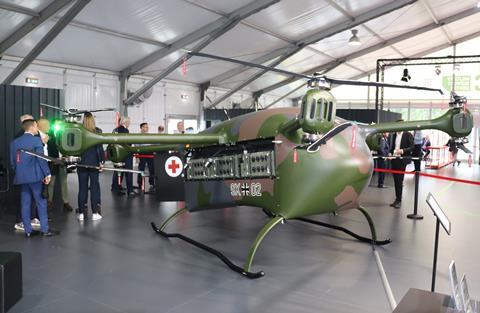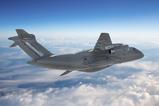It started as a conversation with a general who was interested in fielding a “flying stretcher” – now German developer Avilus is promoting its unmanned Grille platform at the ILA Berlin air show.
Work began in 2021 on the fully-electric ‘multicopter’, which family-owned Avilus says is “specifically designed for the rapid evacuation of wounded soldiers”.
On display in its 9X-02 guise, the Grille (‘Cricket’) has a maximum take-off weight of 750kg (1,650lb). It can carry a payload of approximately 135kg, with a range of around 27nm (50km), and a 46kt (86km/h) cruise speed.

Alternatively, the platform could be equipped with a traditionally fuelled engine, which could extend range performance to up to 215nm, enabling the vehicle to also perform resupply tasks.
“We are currently finalising the development of our second prototype, model 9X-02, starting the flight-test campaign in the next weeks,” Avilus says.
Using civil-certified components such as its electric motors and avionics, the Grille has a system maturity of TRL7, the company’s chief executive Ernst Rittinghaus tells FlightGlobal.
However, the company plans to fly an enhanced -03 model in 2025, which he says will have a lighter and stronger monocoque fuselage structure. It also will be equipped with six recovery parachutes – one fitted to each of its rotor assembly structures.
“We have finished Phase A,” Rittinghaus said at the show on 5 June, referring to the programme’s development phase. “Now we are entering Phase B, when we will go into service. We will be in the market next year, hopefully.”
For patient care, the vehicle is equipped with medical and monitoring equipment, along with video communications linking to a truck-mounted Patient Evacuation Coordination Cell, which also accommodates a remote pilot station.

The Grille system can be transported within a 6m (20ft)-long container, and the air vehicle assembled by two soldiers within 15min without the use of specialist tools.
“For minimum downtime, maximum hygiene and fast decontamination, the cabin container is easily exchangeable,” the company notes.
With a decades-long background in the automotive industry, including designing specialist vehicles for the military, Rittinghaus – who is also a pilot – has grown the company from around 10 employees to more than 60 today.
Asked whether it is difficult to recruit new staff with so much competition for skilled personnel within the German aerospace sector, he states: “With such an interesting programme, it is not a problem.”
Meanwhile, he says a “big brother” for the Grille also will be unveiled by the company next year. While this will be a larger vehicle, it will share the same 8 x 8m footprint of the current design.
“Robotic and autonomous systems are gaining high importance across NATO, being explored and evaluated in various tactical scenarios,” the company says.
Avilus notes that it is working with the German armed forces’ WTD61 unit in Manching as part of a drone innovation hub activity, which includes conducting “comprehensive ground and flight tests of our UAVs”.































